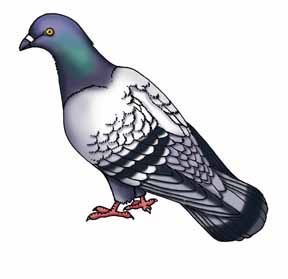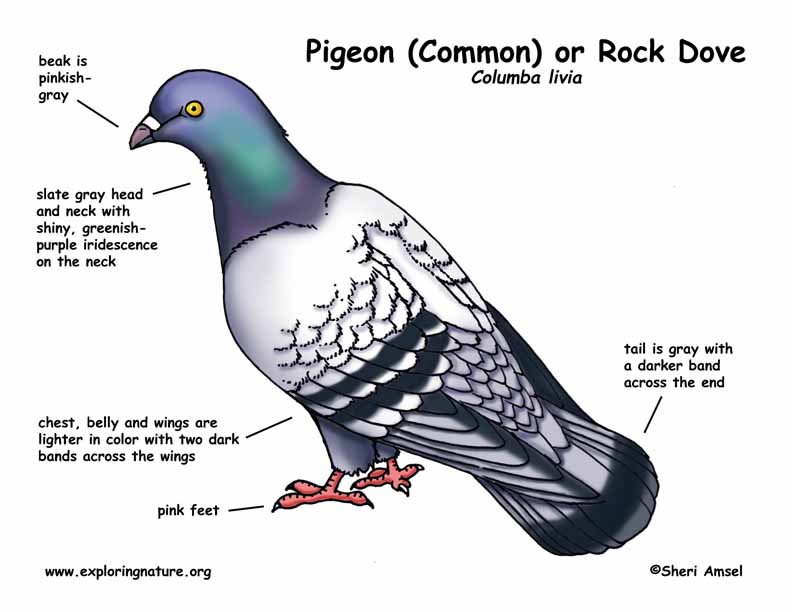

They live in Europe, North Africa and Asia and have been introduced widely throughout North America.
In the wild, they lived in rocky cliffs on the coast or in open scrublands. They have adapted to man in both rural and urban environments, living in barns and on skyscrapers alike.
They are large, rounded birds reaching up to about 13 ounces (368 gm). They can vary widely in color, but most have a slate gray head and neck with some shiny, greenish-purple iridescence on the neck. The chest, belly and wings are lighter in color with two dark bands across the wings. The tail is gray with a darker band across the end. Females are duller in color. The beak is pinkish-gray, as are the feet.
They are active during the day (diurnal) and often gather in large groups (flocks). Nesting pairs are territorial and will attack intruding birds. They are able to find their way home, so have been used historically to carry messages back to their “home base.” When not using flight, pigeons will walk along the ground bobbing their head foward and back.
They are seed-eaters, but will scavenge along the ground and eat anything edible they can find.
They are killed by owls, eagles, falcons, kestrels, opossums and raccoons.
Females lay up to 3 cream-colored eggs in a nest made of sticks and stems built by the male. Nests are perched on cliffs, rocky ledges or skyscraper ledges. Pairs mate for life and both help warm the eggs (incubate) until they hatch in about 3 weeks. They then take turns feeding and caring for the hatchlings. They may have many broods per year.
They live up to 5 years in the wild, but can live up to 15 years in captivity. They have a stable population and are listed as least concern in the IUCN listing.
Kingdom: Animalia
Phylum: Chordata
Subphylum: Vertebrata
Class: Aves
Order: Columbiformes
Family: Columbidae
Subfamily: Columbinae
Genus: Columba
Species: C. livia
When you research information you must cite the reference. Citing for websites is different from citing from books, magazines and periodicals. The style of citing shown here is from the MLA Style Citations (Modern Language Association).
When citing a WEBSITE the general format is as follows.
Author Last Name, First Name(s). "Title: Subtitle of Part of Web Page, if appropriate." Title: Subtitle: Section of Page if appropriate. Sponsoring/Publishing Agency, If Given. Additional significant descriptive information. Date of Electronic Publication or other Date, such as Last Updated. Day Month Year of access < URL >.
Amsel, Sheri. "Pigeon (Common) or Rock Dove " Exploring Nature Educational Resource ©2005-2024. December 13, 2024
< http://www.exploringnature.org/db/view/Pigeon-Common-or-Rock-Dove- >

